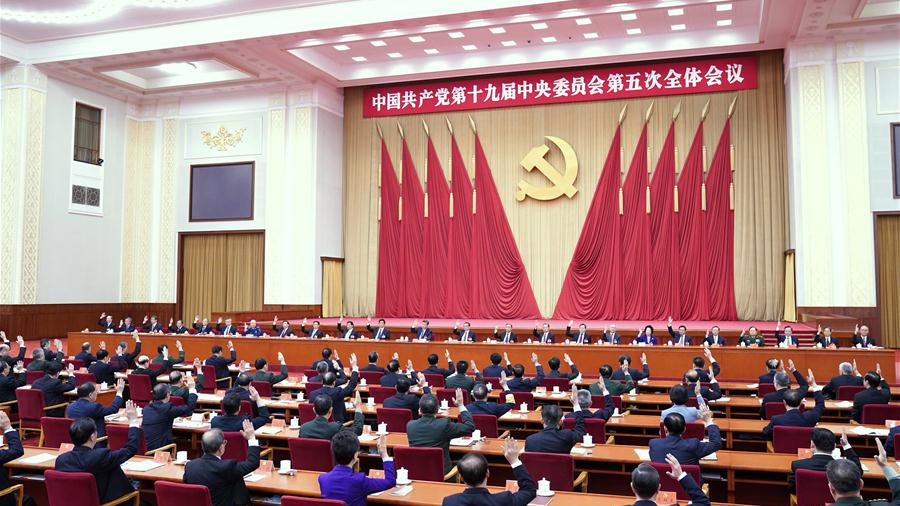
Editor's note: Tom Fowdy is a British political and international relations analyst and a graduate of Durham and Oxford universities. He writes on topics pertaining to China, the DPRK, Britain, and the U.S. The article reflects the author's opinions, and not necessarily the views of CGTN.
After a week of deliberation amongst China's leadership, Friday saw the fifth plenum of the 19th Central Committee conclude and the release of a new communiqué which sets out the country's new five-year plan and vision, the 14th of its kind. These guidelines tell us where China is going, what it hopes to achieve and how it will get there. It comes at a pivotal point in time, whilst Beijing is in a stronger position any time than it has been in modern times, it nonetheless faces new and uncertain challenges, including an increase of hostility from the United States and other Western powers, as well as a global environment beset by problems such as reversals in globalization and of course the consequences of the COVID-19.
Not surprisingly, the new plan emphasizes concepts such as "self-reliance" and "dual circulation"- the latter which refers to combining production and consumption capacities to propel China's growth. The mainstream media may inaccurately refer to these measures as an "inwards turn", not so, they are better described as contingencies. Beijing's attitude towards free trade, export and investment haven't changed and the country will continue opening up.
Rather, these plans represent strategic contingencies and an acknowledgement in some crucial areas, specifically technology; China can no longer be dependent on other countries for certain things and must be prepared to up its game.
For the past 40 years or so, China has been a primary driver of economic growth and globalization. Underpinned by an era of political reconciliation with the West and the open mindset of the Cold War era, growing economic integration was made possible. In many ways this will not actually change in practice, yet the political climate which guaranteed its stability also no longer exists.
A rise in nationalism, populism, great power politics and protectionism have emerged through various reasons and posed disruptions to the global order as we know it. This has been propelled by hostility towards China itself, as legitimated within America and others, and subsequently morphed into technology and trade wars which have pushed the idea that the countries, as well as others, ought to "decouple" in certain strategic areas, attempting to block China's own technological development.

The Political Bureau of the CPC Central Committee presides over the fifth plenary session of the 19th CPC Central Committee in Beijing, capital of China, October 26-29, 2020. /Xinhua
The Political Bureau of the CPC Central Committee presides over the fifth plenary session of the 19th CPC Central Committee in Beijing, capital of China, October 26-29, 2020. /Xinhua
The dilemma Huawei experienced has been a strong warning sign how this environment can quickly become disruptive to China's successes, as well as a demonstration of what needs to be done. Floated on an era of openness, the company grew to become a global brand and player. Yet through ultimate reliance on American manufactured parts and equipment, the United States were able to not only force it out of numerous markets but have likewise attempted to strangle the firm by depriving it of the parts it needed.
Only yesterday the U.S approved new chip-shipments to the company, but leveraged it on what they could and could not be used for (smartphones only, not networks). In Beijing, these pressing events as well as Trump tariffs have been a rude awakening that China cannot rely on the goodwill of others any longer.
As a result: "self-reliance" comes as an aspiration not to withdraw from the world but to in fact accelerate China's own clout in strategic and crucial technologies which are crucial to its continued economic development, which as the above shows the lack of can become a liability. This is a response to global uncertainty, whereby traditional norms of openness are being undermined and national sovereignty is becoming more relevant.
In addition, this underlines the concept of "dual circulation"- the idea that China's own economy should be self-sustaining in a cycle of production and consumption. Again this is not an inwards turn, but a vow to play towards one's own strengths. China has a population of 1.4 billion and the largest consumer market on earth, developing this further is a strategy to negate the damage of efforts such as Trump tariffs and to strengthen China's own industrial capacity.
Given this, The model of international exports, opening markets, multilateral trade and acquiring foreign investment are not about to change and it will continue to promote these principles, that isn't the point, rather this is about making appropriate contingencies in order to mitigate these circumstances and strengthen China's own advantages.
China's economic future is not about low end manufacturing and in this global environment such is perilous, but it is instead about acquiring high-tech capabilities and production, ending dependency on countries hostile to China for these things and ultimately nurturing the domestic market towards a stronger consumer economy.
(If you want to contribute and have specific expertise, please contact us at opinions@cgtn.com.)